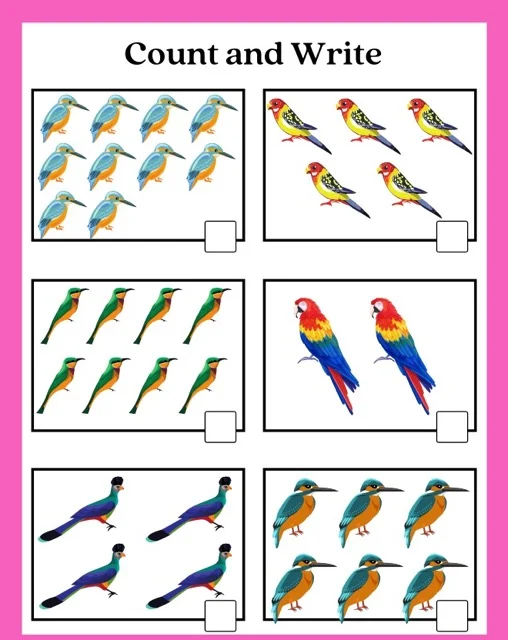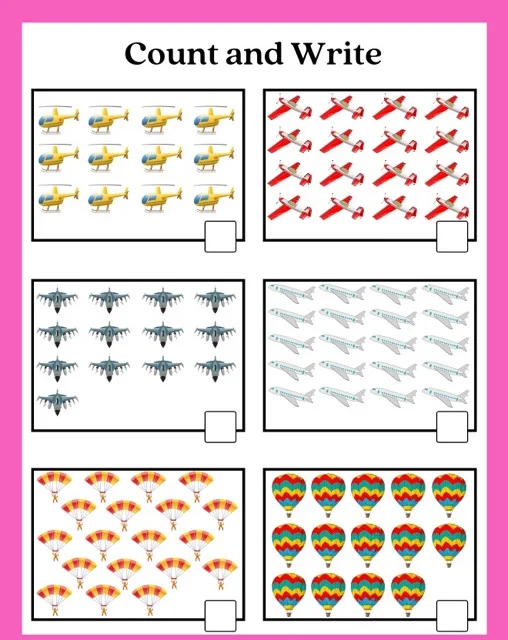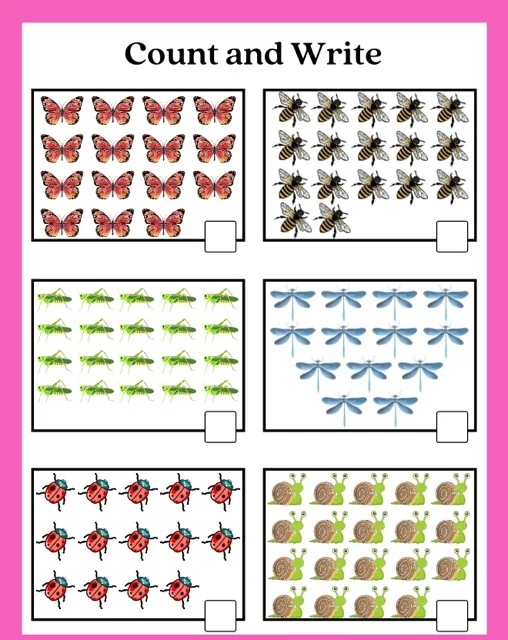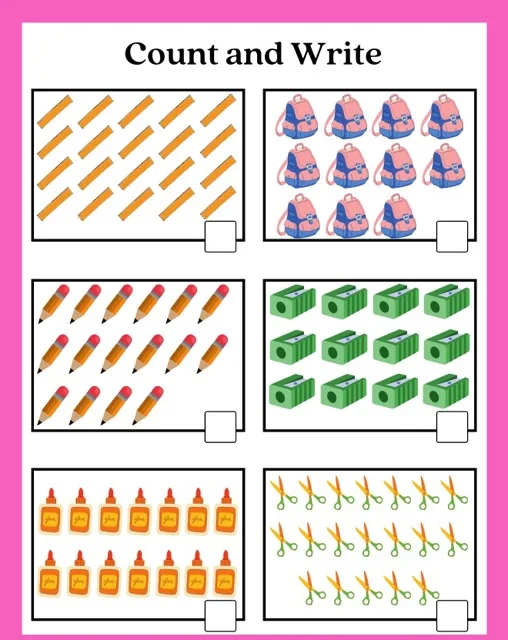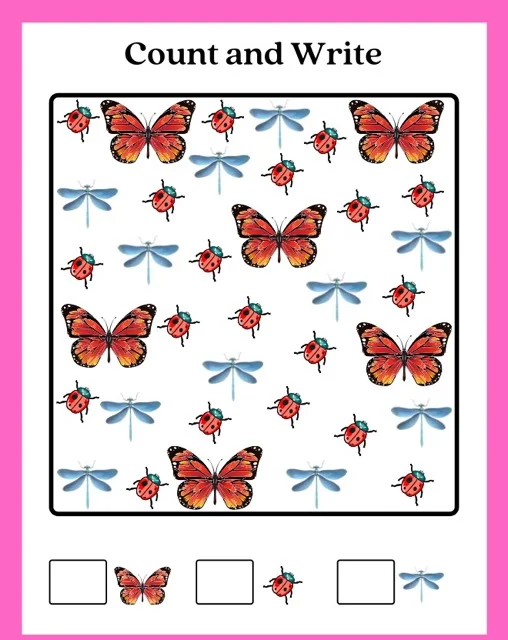Count and Write: Early Math Activities
"Count and Write" is an activity designed to teach preschool and kindergarten children basic math skills, including counting, number recognition, and writing numerals. The activity uses engaging visuals and can be adapted for different skill levels. Its benefits extend beyond math, improving fine motor skills and cognitive development. The activity is adaptable for use at home and in the classroom, fostering a positive learning experience and building confidence. The provided documents detail the activity's purpose, methodology, and various applications.
Count and Write Activity: A Comprehensive Guide
Count and Write Activity: A Briefing Doc
This briefing document reviews the "Count and Write" activity, exploring its purpose, methodology, benefits, and potential applications based on the provided source materials.
I. Purpose & Methodology
The core aim of the "Count and Write" activity is to foster the development of fundamental early math skills in preschool and kindergarten children. These skills include:
●
Counting: Accurately determining the quantity of objects in a set.
●
Number Recognition: Identifying and naming numerals (0-9).
●
One-to-One Correspondence: Understanding that each object in a set is counted only once.
●
Writing Numbers: Practicing the physical formation of numerals.
The activity's structure is straightforward:
1.
A page displays a set of images (e.g., animals, fruits, shapes).
2.
The child counts all the objects within the set.
3.
The child writes the corresponding numeral in a provided box.
II. Target Audience & Adaptability
"Count and Write" is primarily aimed at preschool and kindergarten children learning basic math concepts. However, the activity's difficulty can be adjusted to suit various skill levels:
●
Beginners: Start with smaller sets of simple images.
●
Advanced Learners: Increase the number of objects and use more complex images.
III. Engaging Visuals & Thematic Enhancements
The activity utilizes colorful and engaging visuals to maintain children's interest. Images often depict familiar objects like animals, fruits, flowers, and everyday items.
To further enhance engagement, the guide suggests:
●
Using Real Objects: Children can count and write numbers for objects found in their environment, making the activity more tangible and relatable.
●
Creating Themes: Organizing activities around themes like animals, colors, or seasons can provide a contextual framework and enhance learning.
●
Gamification: Turning counting and writing into a fun competition can boost motivation and enjoyment.
IV. Benefits & Skill Development
Beyond its core focus on math skills, "Count and Write" offers additional benefits:
●
Fine Motor Skill Development: Writing numerals strengthens the small muscles in the hands and fingers, improving dexterity.
●
Cognitive Skill Development: The activity requires concentration, focus, and attention to detail, contributing to cognitive growth.
●
Boosting Confidence in Math: Success in the activity fosters a positive learning experience, laying a foundation for future math learning.
V. Applicability Beyond the Classroom
The "Count and Write" activity is not limited to classroom settings. The guide explicitly states:
"Yes, the "Count and Write" activity can be used at home by parents or caregivers to support their child’s learning. You could gather a group of spoons and have a child count them and write the number in a box."
This versatility makes it a valuable tool for parents and caregivers seeking to reinforce early math concepts at home.
VI. Conclusion
"Count and Write" provides a structured and engaging approach to developing essential early math skills in young children. Its adaptability, visual appeal, and potential for thematic integration make it a versatile tool for educators and parents alike. The activity's benefits extend beyond basic math, contributing to fine motor skill development, cognitive growth, and fostering a positive attitude toward learning.
Count and Write Activity Guide
Count and Write Activity FAQ
1. What is the purpose of the "Count and Write" activity?
The "Count and Write" activity helps children develop essential early math skills. It focuses on:
●
Counting: Accurately counting the number of objects in a set.
●
Number Recognition: Identifying and associating a numeral with its corresponding quantity.
●
One-to-One Correspondence: Matching each object to a single count.
●
Writing Numbers: Practicing writing numerals.
2. How does the activity work?
Each page features a set of images. The child must:
1.
Count all the objects in the set.
2.
Write the corresponding numeral in the provided box.
3. What kinds of images are used?
The activity uses a variety of engaging and colorful images that appeal to young learners. These can include:
●
Animals
●
Fruits
●
Flowers
●
Insects
●
Shapes
●
Everyday Objects
4. What age group is this activity appropriate for?
This activity is suitable for preschool and kindergarten children who are learning to count and recognize numbers.
5. Are there different levels of difficulty?
Yes, the activity can be adjusted to different skill levels.
●
Beginner: Start with smaller sets of objects and simple images.
●
Advanced: Gradually increase the number of objects and use more complex images.
6. How can I make this activity more engaging?
●
Use real objects: Have children count and write numbers for objects found in the classroom or at home.
●
Create themes: Organize the activity around themes like animals, colors, or seasons.
●
Make it a game: Turn counting and writing into a fun competition.
7. What are the benefits of using this activity?
●
Develops foundational math skills: Builds a strong understanding of counting, number recognition, and writing.
●
Encourages fine motor skills: Practice writing numerals.
●
Promotes concentration and focus: Requires attention to detail and accurate counting.
●
Boosts confidence in math: Provides a positive learning experience.
8. Can I use this activity at home?
Absolutely! This is a great activity for parents and caregivers to use at home to support their child's math learning. You can easily create your own "Count and Write" activities using pictures, stickers, or even household items.
Count and Write Activity Guide
Count and Write Activity Guide: A Study Guide
Quiz
Instructions: Answer the following questions in 2-3 sentences each.
1.
What is the primary goal of the "Count and Write" activity?
2.
Describe the two main steps involved in completing a "Count and Write" activity page.
3.
List three examples of the types of images used in "Count and Write" activities.
4.
Identify the target age group for the "Count and Write" activity.
5.
Explain how the "Count and Write" activity can be modified for different skill levels.
6.
Suggest two ways to make the "Count and Write" activity more engaging for children.
7.
How does the "Count and Write" activity contribute to the development of fine motor skills?
8.
What is one cognitive benefit of the "Count and Write" activity?
9.
Can the "Count and Write" activity be used outside of a classroom setting? Explain.
10.
Provide an example of how you could create a "Count and Write" activity using household items.
Answer Key
1.
The primary goal of the "Count and Write" activity is to help children develop essential early math skills, including counting, number recognition, one-to-one correspondence, and writing numbers.
2.
First, the child counts all the objects in the set on the activity page. Then, they write the corresponding numeral in the provided box.
3.
Examples of images used include animals, fruits, and flowers. The guide also mentions insects, shapes, and everyday objects.
4.
The target age group for the "Count and Write" activity is preschool and kindergarten children who are learning to count and recognize numbers.
5.
The activity can be adjusted by starting with smaller sets of simple images for beginners and gradually increasing the number of objects and using more complex images for advanced learners.
6.
To make the activity more engaging, you can use real objects for children to count and write numbers or create themes like animals or colors.
7.
The "Count and Write" activity encourages fine motor skill development as children practice writing numerals.
8.
The activity promotes concentration and focus as it requires attention to detail and accurate counting.
9.
Yes, the "Count and Write" activity can be used at home by parents or caregivers to support their child's learning.
10.
You could gather a group of spoons and have a child count them and write the number in a box.
Essay Questions
1.
Discuss the importance of developing early math skills in preschool and kindergarten children. How does the "Count and Write" activity contribute to this development?
2.
Explain the concept of one-to-one correspondence and its significance in early math education. Provide specific examples of how the "Count and Write" activity helps children understand this concept.
3.
Analyze the effectiveness of using visual aids, such as colorful images and real objects, in the "Count and Write" activity. How do these visual aids enhance the learning experience for young children?
4.
Evaluate the potential benefits of incorporating games and thematic elements into the "Count and Write" activity. How can these strategies increase engagement and motivation in children?
5.
Develop a lesson plan for a "Count and Write" activity that includes objectives, materials, procedures, and assessment methods. Consider the different learning styles and abilities of children in your target age group.
Glossary of Key Terms










